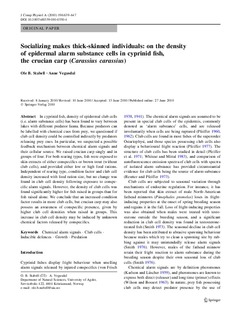Socializing makes thick-skinned individuals: On the density of epidermal alarm substance cells in cyprinid fish, the crucian carp (Carassius carassius)
Journal article, Peer reviewed
Permanent lenke
http://hdl.handle.net/11250/138251Utgivelsesdato
2010Metadata
Vis full innførselSamlinger
Originalversjon
Stabell, O. B., & Vegusdal, A. (2010). Socializing makes thick-skinned individuals: on the density of epidermal alarm substance cells in cyprinid fish, the crucian carp (Carassius carassius). Journal of Comparative Physiology A: Neuroethology, Sensory, Neural, and Behavioral Physiology, 196(9), 639-647. doi: 10.1007/s00359-010-0550-4Sammendrag
In cyprinid fish, density of epidermal club cells (i.e. alarm substance cells) has been found to vary between lakes with different predator fauna. Because predators can be labelled with chemical cues from prey, we questioned if club cell density could be controlled indirectly by predators releasing prey cues. In particular, we suspected a possible feedback mechanism between chemical alarm signals and their cellular source. We raised crucian carp singly and in groups of four. For both rearing types, fish were exposed to skin extracts of either conspecifics or brown trout (without club cells), and provided either low or high food rations. Independent of rearing type, condition factor and club cell density increased with food ration size, but no change was found in club cell density following exposure to conspecific alarm signals. However, the density of club cells was found significantly higher for fish raised in groups than for fish raised alone. We conclude that an increased condition factor results in more club cells, but crucian carp may also possess an awareness of conspecific presence, given by higher club cell densities when raised in groups. This increase in club cell density may be induced by unknown chemical factors released by conspecifics.
Beskrivelse
Published version of an article in the journal: Journal of Comparative Physiology A: Neuroethology, Sensory, Neural, and Behavioral Physiology. Also available on SpringerLink: http://dx.doi.org/10.1007/s00359-010-0550-4
